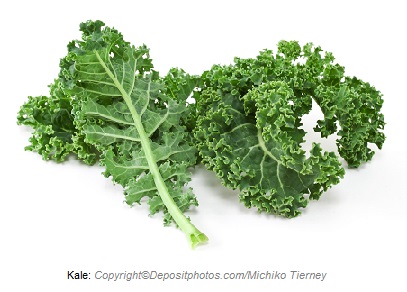Kale is a green leafy vegetable from Brassica family and related closely to  cabbage and broccoli. It is sometimes called “borecole” as well. One cup of chopped and uncooked kale contains 7 grams of carbohydrates, 2 grams of fiber and 2 grams of protein.
cabbage and broccoli. It is sometimes called “borecole” as well. One cup of chopped and uncooked kale contains 7 grams of carbohydrates, 2 grams of fiber and 2 grams of protein.
Average calories: 36 per one cup, chopped and uncooked.
|
Kale: one cup, chopped and uncooked |
|
|
Carbohydrate |
7 |
|
Fiber |
2 |
|
Protein |
2 |
|
Fat |
0 |
|
Calories |
36 |
Vitamins found in higher amounts: vitamins A, K, C, B6, B2 and B1. One cup of chopped kale provides 10300 IU of vitamin A, 550 mcg of vitamin K, and 80 mg of vitamin C.
Minerals found in higher amounts: manganese, copper, potassium, calcium, magnesium and iron.
Phytonutrients found in higher amounts and their health benefits: kale is rich in numerous phytochemicals and they include indole-3-carbinol, diindolylmethane, sulforaphane, isothiocyanates, carotenoids, and flavonoids.
Indole-3-carbinol is a phytonutrient that can reduce risk of developing estrogen-related cancers by altering the metabolism of estrogen. In fact, indole-3-carbinol is an anti-estrogen. Indole-3-carbinol is also found in cabbage, cauliflower, Brussels sprouts, broccoli and collard greens.
Diindolylmethane (DIM) comes from the breakdown of indole-3-carbinol in the body and has anti-viral, anti-bacterial, anti-androgenic, and anti-inflammatory properties. DIM reduces risk of developing cancers by preventing from angiogenesis. DIM shows activity against HPV (human papilloma virus) as well.
Sulforaphane can inhibit the growth of Helicobacter Pylori, a microbe responsible for peptic ulcer and stomach upset. Sulforaphane is also found in Bok Choy,Brussels sprouts, cabbage, cauliflower, broccoli, collards, kohlrabi, mustard, turnip, radish, arugula, and watercress.
Isothiocyanates induce apoptosis (programmed cell death) in certain cancers. However, the downside of isothiocyanides is that they interfere with uptake of iodine, leading to goiter (enlargement of thyroid gland).Isothiocyanates can enhance liver detoxification by stimulating both phase I and phase II of detoxification process.
Beta-carotene, lutein and zeaxanthin are the carotenoids found in substantial amounts in kale. They are antioxidants with protective effects on the eyes.
Flavonoids have anti-inflammatory, cancer-preventing, anti-oxidative, and immune system-enhancing properties.

